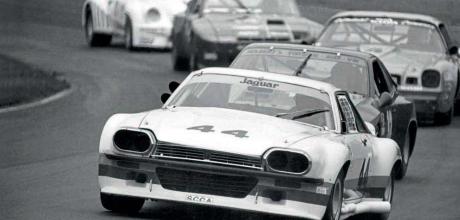Group 44 Jaguar XJ-S finishes second in the 1981 Trans-Am Series
Even though Bob Tullius’ Group 44 team won the 1978 Sports Car Club of America Trans-Am Series with a largely standard XJ-S, Jaguar North America withdrew its sponsorship, leaving the Virginia-based outfit to concentrate on its Triumph TR8 campaign instead.
Finishing Lines
Jaguar sanctioned a return two years later, but a change of rules by the SCCA meant that Group 44 had to build a brandnew spaceframe ‘silhouette’ car that was then clothed in non-structural, lightweight XJ-S panels. A pure racer, it weighed a mere 1,295kg (400kg less than a standard road car), while the Group 44-built V12 – which developed around 550bhp – was pushed further back in the chassis for better weight distribution. A quick-change differential replaced the Salisbury unit and there was custom-made suspension.
Christened the XJR-4, it was Group 44’s first custom-made racing car. With Tullius himself at the wheel, the car proved quick from the off. It finished second at the season opener on 17 May 1981 at Charlotte, North Carolina, followed by its first overall victory at Portland, Oregon, four weeks later. Electrical problems saw Tullius retire at the next two outings, but he won again at Brainerd, Minnesota, on 9 August. A rare timing chain breakage meant the XJ-S didn’t finish at Trois-Rivières, Quebec, on 6 September, but another win at Mosport a week later kept Tullius in contention for the overall championship.
Unfortunately, gearbox trouble in the penultimate round at California’s Laguna Seca circuit meant Tullius finished fifth, handing the series championship to the Chevrolet Corvette-driving Eppie Wietzes. Although Tullius retired from the ninth and final race of the 1981 Trans-Am Series at Sears Point on 25 October, his three wins and a second were enough to finish second overall, a fine result for a new car against stiff opposition.
The following January, the car was entered in the 1982 Daytona 24 Hours, mainly to test the V12 over 24 hours in readiness for Group 44 entering endurance racing with the mid-engined XJR-5 in 1983. It finished a credible 21st overall and sixth in the Grand Tourer Prototype class.
Gordon Smiley, Tullius’ Daytona co-driver, was supposed to race the car in that year’s Trans-Am Series. He had even secured sponsorship from Intermedics, a manufacturer of pacemakers, but he sadly died on 15May while qualifying for the Indianapolis 500. Consequently, Tullius drove the now red-and-white car at Road Atlanta a week later – the only time a Group 44 car didn’t compete in the familiar livery of oil company Quaker State – before then retiring the car from competition.
The car became a test mule for the XJR-5, and was then sold. Still in private ownership, this important part of Jaguar’s racing history is occasionally seen at historic events.


